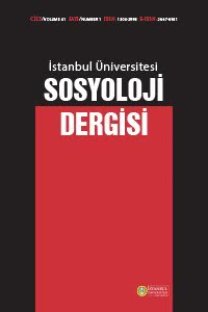Revisiting Institutional/Occupational Model in Turkish Military
Military sociology, Institutional/occupational Model, Charles Moskos, Civil-military relations Turkish Military,
___
- Akça, İ. (2004). Kolektif bir sermayedar olarak Türk Silahlı Kuvvetleri. A. İnsel & A. Bayramoğlu (Eds.), Bir zümre, bir parti, Türkiye’de Ordu, Birikim’den seçmeler: 2 (pp. 225-269). Birikim Yayınları.
- Akyürek, S., & Yılmaz, M. A. (2013). Türk Silahlı Kuvvetleri’ne toplumsal bakış (Bilge Adamlar Stratejik Araştırmalar Merkezi, Rapor no: 56).
- Caforio, G. (1988). The Military Profession: Theories of Change. Armed Forces & Society, 15(1), 55–69. https://doi.org/10.1177/0095327x8801500104
- Cakatay, O. (2019). Evaluation of paid military service in Turkey using a population representation model (Master’s thesis, Naval Postgraduate School). https://apps.dtic.mil/sti/pdfs/AD1073603. pdf
- Canveren, Ö. (2021). Türkiye’de ordu- siyaset- toplum ilişkilerinin genel bir panoraması: Tarihselsosyolojik bir değerlendirme. Mülkiye Dergisi, 45(1), 125–153. https://dergipark.org.tr/en/pub/ mulkiye/issue/61971/927461
- Çarkoğlu, A., & Adaman, F. (2000). Devlet reformu: Türkiye’de yerel ve merkezi yönetimlerde hizmetlerden tatmin, patronaj ilişkileri ve reform. https://www.tesev.org.tr/wp-content/uploads/ rapor_Turkiyede_Yerel_Ve_Merkezi_Yonetimlerde_Hizmetlerden_Tatmin_Patronaj_Iliskileri_ Ve_Reform.pdf
- Demirel, T. (2002). Türk Silahlı Kuvvetleri’nin toplumsal meşruiyeti üzerine. Toplum ve Bilim, 93, 29–54.
- Hale, W. (1994). Turkish politics and the military. Routledge.
- Köktürk, A. (2021). Türk Ordusunun sermaye ile ilişkisi ve ordu-siyaset ilişkisinin dönüşümü. İnsan ve İnsan Dergisi, 8(29), 15-29. https://doi.org/10.29224/insanveinsan.908922
- Moskos, C. C. (1977). From institution to occupation. Armed Forces & Society, 4(1), 41–50. https:// doi.org/10.1177/0095327x7700400103
- Moskos, C. C. (1986). Institutional/Occupational Trends in Armed Forces: An Update. Armed Forces & Society, 12(3), 377–382. https://doi.org/10.1177/0095327x8601200303
- Nielsen, S. C. (2012). American civil-military relations today: the continuing relevance of Samuel P. Huntington’s The Soldier and the State. International Affairs, 88(2), 369–376. https://doi. org/10.1111/j.1468-2346.2012.01076.x
- Nuciari, M. (1994). Rethinking the Military Profession: Models of Change Compared. Current Sociology, 42(3), 7–21. https://doi.org/10.1177/001139294042003003
- “Paşaların emekli ikramiyesi biliyor musunuz?” (2013, July 15). Milli Gazete. https://www. milligazete.com.tr/haber/1052933/pasalarin-emekli-ikramiyesi-biliyor-musunuz
- Pehlivan, C. (2009). Türk Silahlı Kuvvetleri’nin güvenirliği üzerine bir araştırma ve ordu millet geleneği (Yüksek lisans tezi, İstanbul Üniversitesi Sosyal Bilimler Enstitüsü, İstanbul). http:// nek.istanbul.edu.tr:4444/ekos/TEZ/45202.pdf
- Pratt, G. J. (1986). Institution, occupation and collectivism amongst Australian Army officers. Journal of Political & Military Sociology, 14(2) 291–302.
- Sakallioğlu, Ü. C. (1997). The anatomy of the Turkish Military’s political autonomy. Comparative Politics, 29(2), 151–166.
- Segal, D. R. (1986). Measuring The Institutional/Occupational Change Thesis. Armed Forces & Society, 12(3), 351–375. https://doi.org/10.1177/0095327x8601200302
- Segal, D. R., & Segal, M. W. (1983). Change in Military Organization. Annual Review of Sociology, 9(1), 151–170. https://doi.org/10.1146/annurev.so.09.080183.001055
- Smokovitis, D. (1984). From institutional to occupational values: Trends in the Greek Military. In Military and society: The European experience (pp. 361–386) (SOWI-FORUM International 4). SOWI.
- Soeters, J. L. (1997). Value orientations in military academies: A thirteen country study. Armed Forces & Society, 24(1), 7–32. https://doi.org/10.1177/0095327x9702400101
- Sørensen, H. (1994). New Perspectives on the Military Profession: The I/O Model and Esprit de Corps Reevaluated. Armed Forces & Society, 20(4), 599–617. https://doi. org/10.1177/0095327x9402000407
- ISSN: 1304-2998
- Yayın Aralığı: 2
- Başlangıç: 2020
- Yayıncı: İstanbul Üniv. Edebiyat Fak. Sosyoloji Böl.
Hasan Hüseyin BALIK, Adem BAŞPINAR
Militarizasyon MENA Ülkelerinde Çevresel Kirliliği Nasıl Etkiliyor?
“Ben ve Öteki” Bağlamında Yakup Kadri’nin Sodom ve Gomore Romanında Yabancı Askerler
Ebedi Barış ve Askeri Sosyoloji İlişkisi Üzerine Bir İnceleme
Köktürk Yazıtlarının “Askerî Propaganda” Bağlamında Değerlendirilmesi
Türkiye’de Profesyonel Askerliğin Sosyolojik Bir İncelemesi: Meslek, Görev ya da Yaşam Tarzı?
Askerî Sosyolojide Sivil-Asker Mesafesi Tartışmaları
Mustafa Yücehan AKAL, Adem BAŞPINAR
Sosyal İlişkiler Ölçeği’nin Geliştirilmesi ve Psikometrik Özellikleri
